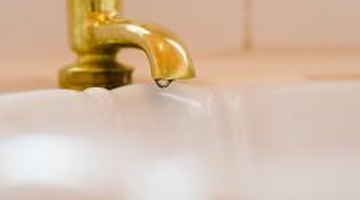Can I Connect a Galvanized Pipe to a Brass Faucet?
Joining two dissimilar metals such as iron and brass causes corrosion due to weak electrical currents flowing between the two metals. This process, called galvanic corrosion, gradually erodes the galvanized iron pipe without harming the brass faucet. Either galvanized iron or brass can contain lead, and corrosion can leach the lead in either component into the drinking water. Galvanized iron pipe can corrode for other reasons even if matched to compatible metal fittings such as aluminum.
Corrosion

Metal corrodes through a combination of chemical and electrical reactions. Iron in the walls of a galvanized iron pipe combines chemically with dissolved oxygen in the water the pipe carries. Electrical differences between different areas of the iron pipe cause iron ions to move out of the metal, creating pits. When two metals with very different rates of natural corrosion touch, the metals exchange electrons. Metal ions flow out of the anode, or positively charged metal in the pair, causing corrosion. Metals with very different ranks in the galvanic series, a measurement of tendency to corrode, generate stronger galvanic corrosion when joined.
Compatible Metals
Joining two metals with similar rates of corrosion slows galvanic reactions and neither metal corrodes significantly. Fitting an aluminum fixture to a galvanized iron pipe causes no problems, since aluminum and iron rank nearly the same on the galvanic scale. Fitting brass to nickel also reduces galvanic action. Iron corrodes much more easily than brass, however, so joining these two metals accelerates the rusting of the iron. The more active metal in the galvanic pair becomes the anode and dissolves away. Fitting a brass faucet to a galvanized iron pipe always causes the slow destruction of the pipe.
Lead Dangers
Manufacturers of galvanized iron pipe increased the corrosion resistance of the pipe by electroplating the iron with zinc alloy. Zinc ranks much higher on the galvanic scale than iron, and through galvanization the iron acquires a protective coating of zinc ions. Lead and cadmium were common contaminants in zinc alloys used in electroplating iron pipes, according to the Alabama Cooperative Extension. Galvanized pipes can release both of these poisonous metals as pipes corrode. Brass fittings also release lead into drinking water through corrosion. Although modern brass fittings contain less lead, alloys labeled "lead-free" can still contain 8 percent lead.
Options
Old galvanized pipe clogs with rust and scale will eventually need replacement. Copper tubing, brass pipe or plastic pipe safely replaces iron pipe, and special fittings can match brass faucets to plastic pipes. Joining a brass faucet to compatible copper tubing or brass pipe also prevents galvanic corrosion. Any metal pipes and fittings carrying corrosive, oxygen-rich water constantly release metal ions as surfaces dissolve. Running the water until the temperature drops noticeably empties pipes of standing water and reduces risks of ingesting dangerous metals, according to the Mesa, Arizona, city website. Use water from the cold side of the system for drinking and cooking.
Resources
Writer Bio
James Young began writing in 1969 as a military journalist combat correspondent in Vietnam. Young's articles have been published in "Tai Chi Magazine," "Seattle Post-Intelligencer," Sonar 4 ezine, "Stars & Stripes" and "Fine Woodworking." He has worked as a foundryman, woodturner, electronics technician, herb farmer and woodcarver. Young graduated from North Seattle Community College with an associate degree in applied science and electronic technology.
Photo Credits
- Jupiterimages/Polka Dot/Getty Images
More Articles



